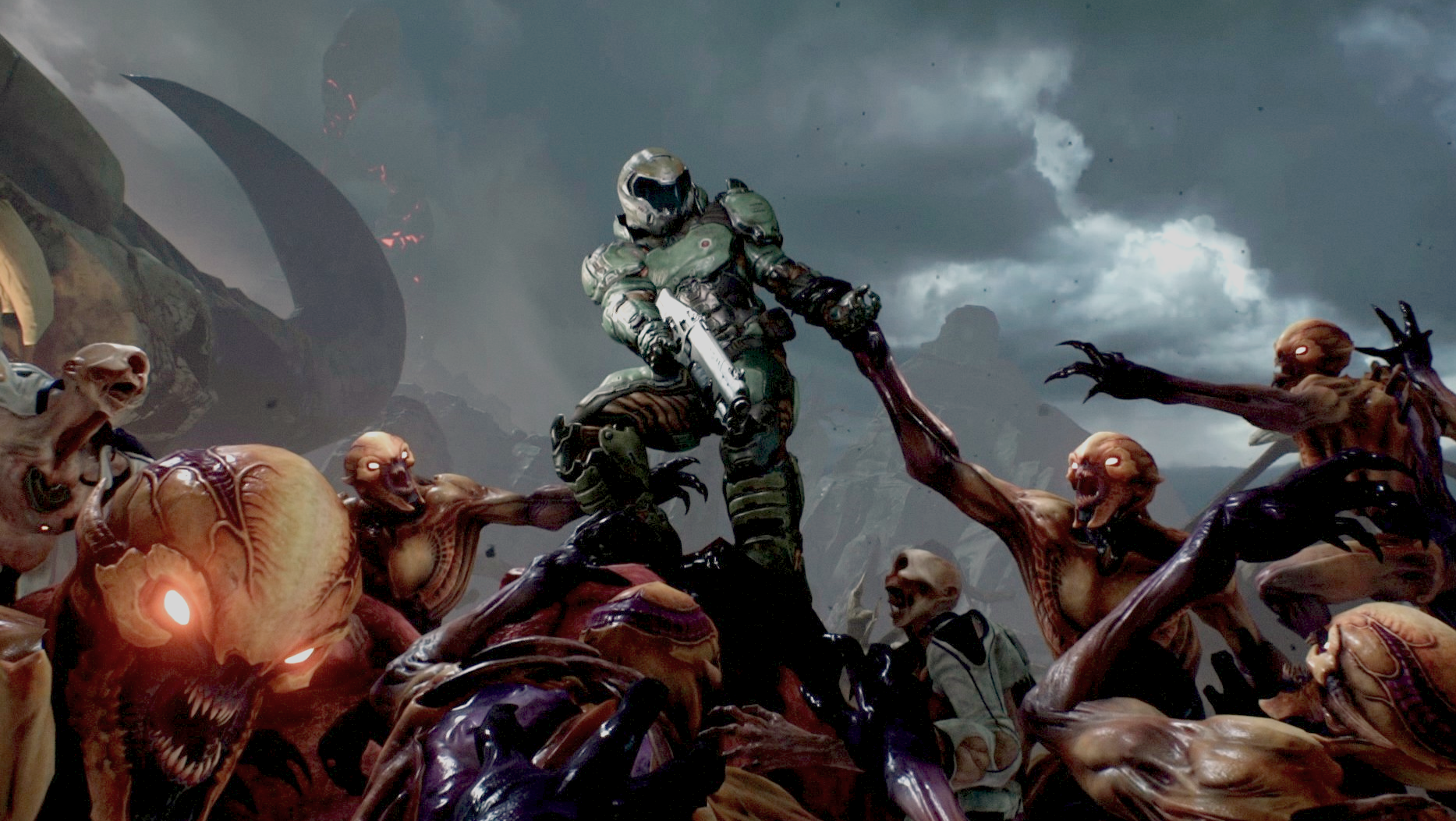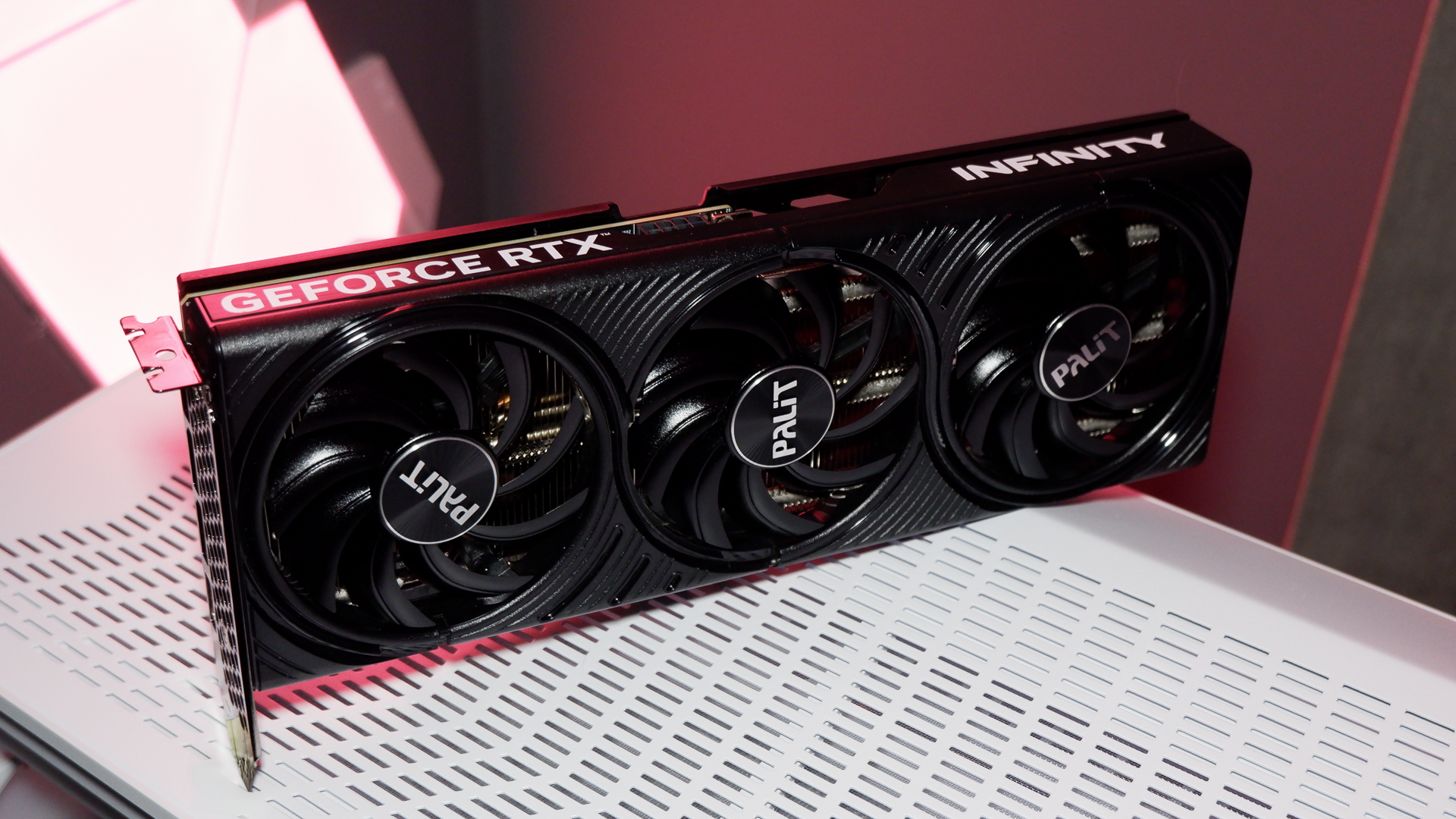Our Verdict
Despite a drab multiplayer mode and limited level creation tools, Doom is a cheeky and fulfilling return to pared-down acrobatic gunplay.
PC Gamer's got your back
What is it? A fast, furious first-person shooter on Mars
Reviewed on: Nvidia GTX 980 Ti, Intel Core i7-6700K, 16GB RAM
Price: $60 / £40
Release date: May 12, 2016
Publisher: Bethesda Softworks
Developer: id Software
Multiplayer: Co-op (SnapMap) and PvP
Link: Official website
Above anything else, Doom is an action comedy that reveres every FPS trope it had a hand in creating. A cheeky manifestation of space marine bullshit turned up to 11, the Doom Marine is vindication, rage, violence, and masculine excess personified. In Doom’s opening minutes, he wakes from a long sleep inside a demonic sarcophagus and pops the heads of several possessed Mars zombies. In the next room, the Doom Suit rests, surrounded by a jumble of candles and demonic insignia signposting in capital letters: This thing here? It’s important. I feel the same reverence. I climb inside. From there, it's a rude journey to shut hell the hell up.
Abated by a dull multiplayer mode, a limited level creation toolset, and a familiar art direction that doesn't feel as malevolent or creative as modern technology allows, my journey is otherwise one of playful, indulgent FPS action. Hell is my home now, and I won’t leave until a better source of unadulterated fun guts me out.
Hell? Yes.
The story partners you up with Samuel Hayden, a high-ranking UAC (Union Aerospace Corporation) official who worked on secretive Argent energy research projects on Mars. He’s not a fan of hell either. Our primary villain, high-ranking UAC scientist Olivia Pierce, wants the opposite. Satan and co. promised her “great things.” Guess how that one turns out. The plot is dead simple and easy to ignore, loose scaffolding for the furious gunplay, which suits Doom. But for the curious, codexes scattered through the environments detail characters, locations, and enemies in intentionally overwrought high-fantasy strokes.
We’re meant to inhabit the blind, dumb rage of Doom Guy.
I couldn’t take any of it seriously, and that’s the point. They imply hell has a history, civilization, hierarchy, and so on—it makes battles just a touch more personal, but I’m not weeping for every eviscerated Hellknight. It’s hard to imagine them after hours, having a friendly chat over a mug of hot blood, snacking on artisanal entrails. We’re meant to inhabit the blind, dumb rage of Doom Guy, a man who punches helpful drones after they upgrade his weapons, a man who knocks over computers just because, a man whose sole purpose is to be a relentless, unfeeling human tank.
Levels tend to have a singular goal outlined at the beginning by Samuel—turning off comm arrays and switching all sorts of important videogame switches—and end in a gigantic battle accompanied by a huge destructive event that the Doom Guy kicks off with inevitable overkill. It's routine FPS stuff, but filtered through Doom’s exaggerated tone, nearly everything you do is poised to be absurd and funny. One level has your friendly AI companion guiding you through his shutdown process. As I methodically dismantle his power and cooling systems, the AI continually explains away his impending ‘death’ as a utilitarian necessity in a soothing pre-programmed voice. I felt bad for laughing, but Doom Guy couldn’t care less.
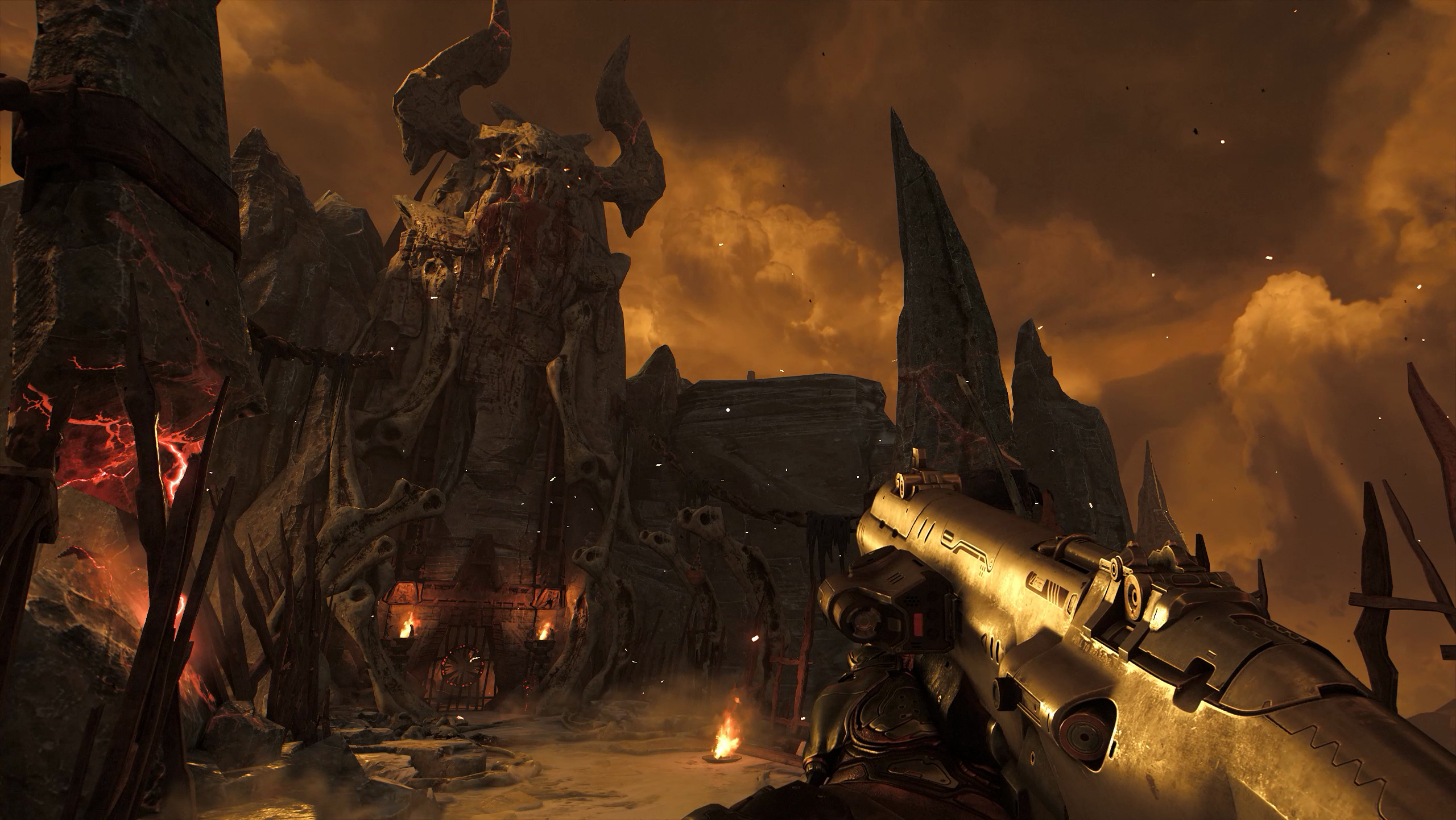
For all its brutal violence and dispiriting Satanic imagery, Doom is charitably paced. Environments are a sprawl of corridors that span multiple levels of industrial mars facilities or the rocky islands of hell. I spent more time exploring the environments looking for yellow keycards or secrets than I did in combat, punctual bursts of action that demand intense focus.
Enemies spawn by the dozen; some pursue with melee in mind and others hang back and fire projectiles, and the variety expands throughout a given fight. One enemy can teleport around the arena and spawn minions, which forces me to prioritize them over every other threat. Problem is, they’re quick and small. Some are quick and very tall. Some fly and shoot fireballs. Most have horns and gaping mouths with sharp canines—they’re an imposing bunch, but the majority are familiar faces rendered in an unsurprising and tame 3D aesthetic.
Doom and Doom 2 weren’t exclusively action exploration romps, they were also survival horror games. Limited by the era’s hardware and development bottlenecks, Doom and Doom 2’s forced minimalism let my imagination do the heavy lifting. They were my first prolonged experience with occult imagery that felt simultaneously wrong and magnetic.

Which is why seeing a Pinky demon realized as a cute reptilian monster, or Hell as a cluster of floating stone spires adorned with cartoonish demon skulls, diminishes the sense that I’m playing something I shouldn’t. It’s all very rad, but it’s never quite bad (in a don’t-tell-my-dad sense). I wouldn’t be surprised to find an identical underworld in World of Warcraft, so after seeing how well id Software interpreted and elevated Doom’s run-and-gun play, I’m slightly disappointed they went with such a safe rendition of hell and its inhabitants.
Parkgour
For a complete performance breakdown, check out our benchmarking post, where we tested Doom on 15 different graphics cards. Overall, it's looking good.
Doom’s story and art direction take a backseat to gunplay, and it makes that abundantly clear right away. There is no reload button. All you need to worry about is pulling whatever trigger you can. The super shotgun explodes, dissolving anything in its immediate path and drowning out the sound mix with a clap. Doom would dent your eardrums against your will if it could. My weapon of choice, the rocket launcher, shoots slow singular rounds. The satisfaction of predicting where a target will be and firing a rocket a full second before it connects never gets old. Classic Doom weapons fill out the arsenal, albeit with updated designs and secondary functions. It's nice to see them again, though they’re not bursting with newness.
Weapon abilities are extended through the addition of upgradable mods that add an alternate fire option to each gun. The shotgun gets a three shot burst, the gauss rifle gets a scoped charge shot—most are methods for doing more damage at the cost of consuming ammo quicker. If I need a Baron of Hell out of the picture sooner than later, I’ll take the compromise and empty my gauss rifle reserves in a heartbeat; it’s satisfying, and the ammo cost forces experimentation with every weapon. A few offer methods of AoE damage and crowd control. By right-clicking with a rocket launcher mod, you can explode the round anywhere on its trajectory. If I see a cluster of enemies or know a shot will miss, I’ll pop that round to make sure it’s not wasted. The plasma rifle has an alt fire that stuns enemies for a short period. If I’m cornered by a few Hell Knights, I stun and run. While the gun viewmodels aren’t much to look at, each a static smattering of greys and blacks, they feel great in your hands and force diversity enough to make every combat encounter feel different.
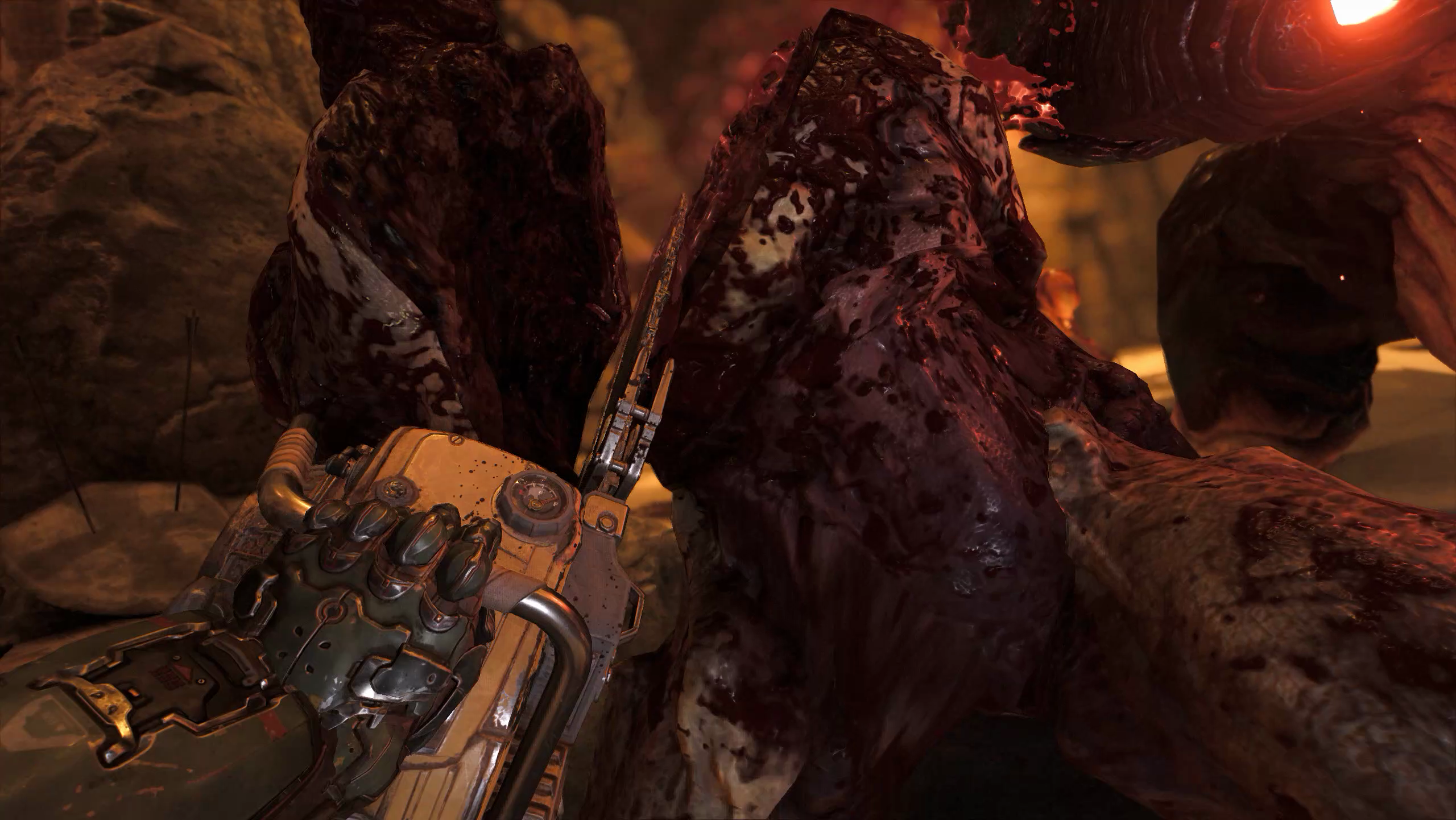
It’s Doom’s emphasis on mobility and spontaneity that makes everything work. Aiming down the scope of the gauss rifle while strafing is one thing, but aiming down its scope why flying over the entire stage after hitting a jump pad with Haste (a speed powerup) active is another. Your base movement speed is faster than a sprint in most other FPSes, and that quickness motivates you to move constantly to kite, dodge, and lunge at demons, some of which are as agile as you. Almost all arenas have little terraces and mesas you can double-jump onto, along with hidden powerups and ammo and health pickups. If I died, I switched up my weapon choices, tried to explore more of the arena, and if things got dire enough, I equipped new runes.
It’s Doom’s emphasis on mobility and spontaneity that makes everything work.
Rune challenges are time trials hidden throughout the campaign that reward you with equippable perks that give a small boost to certain abilities. My favorite extends the reach at which I can execute Glory Kills, quick melee animations that guarantee health drops you can perform once an enemy has taken a significant amount of damage and enters a stagger state. Since executing a Glory Kill shoots you toward that enemy, I’m able to close a 20 yard gap almost instantly. Paired with a rune that makes enemies stagger sooner and another that gives me a temporary speed boost after performing a Glory Kill, I can zip across an arena and take out several enemies in about 10 seconds (if I don’t miss), and heal along the way. I’m still excited to try out new rune and weapon combinations just to find new ways of emptying a room with panache.
The cherry on top is the chainsaw, which prevents combat from devolving into a desperate search for resources by functioning as a limited ammo regain tool. Spend some chainsaw fuel to treat yourself to a grisly show and a guaranteed shower of ammunition. Chainsaw use and Glory Kills are rewarding resource management mechanics that force me to keep an eye on ammo, health, and to not outright liquify every enemy on sight.
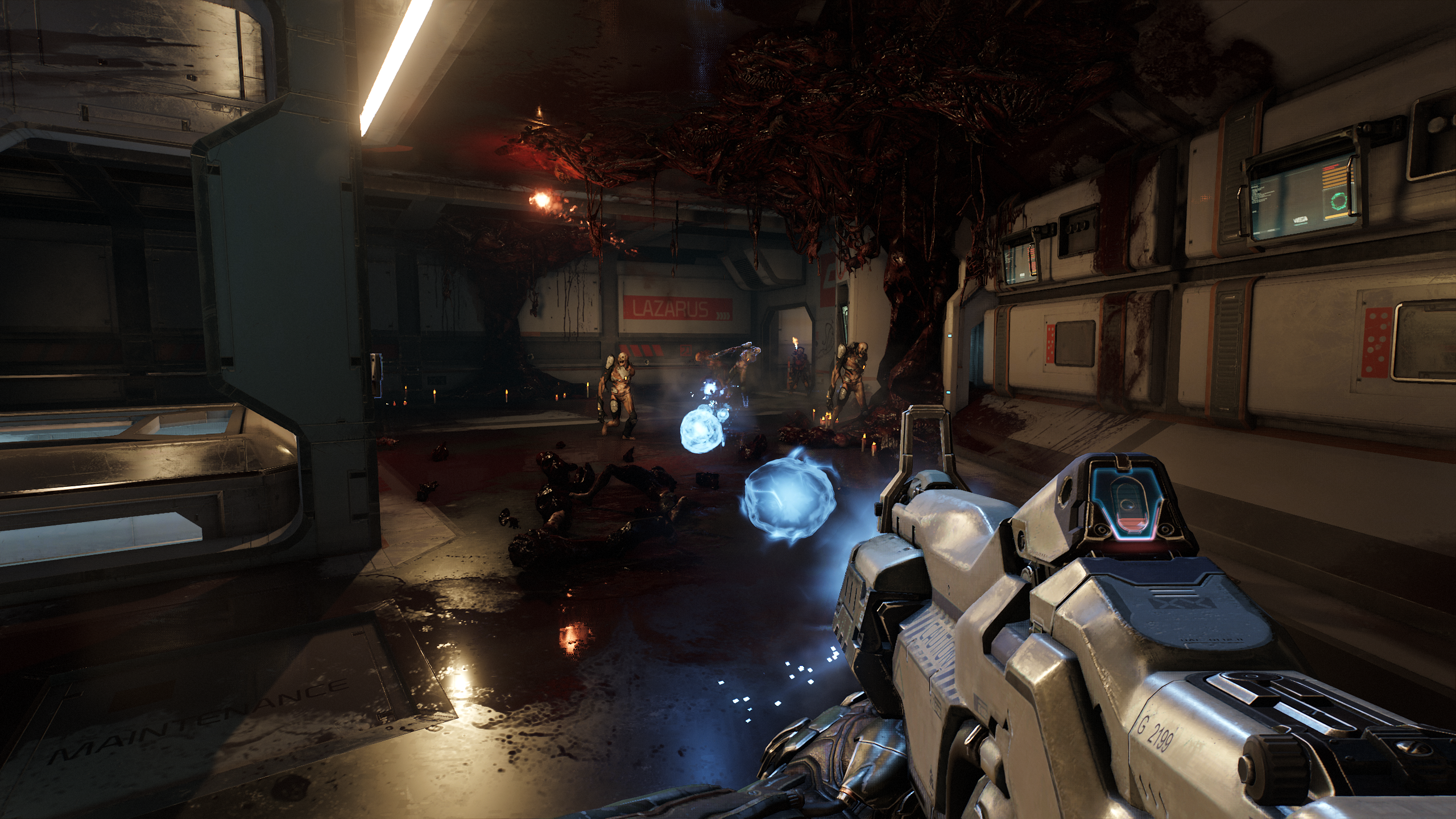
Doom’s combat is a bumping demonic dance floor, where standing still kills the vibe (me) and the most popular demon is somewhere across the crowded room. Getting there without tripping up requires close study of the floor, creative use of my arsenal, and no small amount of jumping and strafing. The only thing missing is a live band improvising to my sweet moves, but the inspiring fuzz and pulse of industrial metal will do.
SnapMap and multiplayer
Within my first hour of exploring the user-made levels of SnapMap, Doom’s proprietary level creation tool, I tended to my farm and explored demonic mines in Harvest Doom, gave birth to a litter of imp-shaped racoons and consumed trash to stay alive, and raced through a series of challenging parkour time trials—there’s no shortage of good ideas showing up in SnapMap by the minute, and it’s easy to find or create them via simple tools. I just worry SnapMap’s hard limits won’t support an active community on the PC. Only 12 monsters can inhabit a map at once, environment design is limited to prefabricated modules, and the logic system, while simple to use, is unreliable and buggy. Enemies have trouble with pathing routines and I’ve had switches fail at random. There’s incentive for players to create experimental (but shallow) non-Doom experiences and traditional Doom-Doom experiences, but there’s no room for expression beyond SnapMap’s limited scope. It makes the lack of mod support, one of the primary reasons Doom is still such a recognizable name today, sting more than normal.
I gave birth to a litter of imp-shaped racoons and consumed trash to stay alive.
The soupy chaos of the campaign and strange surprise of SnapMap don’t translate to multiplayer. Firefights are often a matter of who saw who first, or happened to collect more armor after spawning. Scattered around are special weapons, health pickups, and demon rune power-ups, which turn one lucky player into a devastating demonic force, but the presence of a progression system upsets the balance. Weapons and hack modules, temporary boosters to XP or armor that kick off after respawning, are locked behind levels and pull opposite to the ethos of games with similar shooting mechanics.

Doom’s quick movement and twitchy arsenal are deliberately old school, but feel like a half measure when compared to the new Unreal Tournament, where everyone starts and stays on even footing. I enjoyed customizing my character with clashing metallic colors and a hodgepodge of garish armor pieces. During multiplayer, those decisions aren’t meaningful until the victory screen, where the top players get to do a dance or taunt in front of everyone. There’s fun to be had in the multiplayer, but it’s diluted by an excess of indistinct modes and the sterile progression system. Doom’s multiplayer fails to carve out an identity of its own, abandoning the pursuit of new ideas in favor of forcing in popular ones. Thankfully, It’s easy to ignore in favor of the excellent campaign, where the bulk of Doom’s love is reserved.
With Doom’s campaign, id Software found a sweet spot nestled somewhere between nostalgia and modernity that celebrates the pulpy sheen of big-budget shooters and resurrects an intense, simplified focus on the shooting itself. Doom sticks a bit too close to home to reinvigorate the genre, but it’s a reminder that FPS games aren’t limited to stop and pop corridors and political melodrama. It’s a reminder that sometimes a controlled, crafted appeal to base desires—going fast, flying high, and swift, tongue-in-cheek demon justice—is more than enough.
Despite a drab multiplayer mode and limited level creation tools, Doom is a cheeky and fulfilling return to pared-down acrobatic gunplay.
James is stuck in an endless loop, playing the Dark Souls games on repeat until Elden Ring and Silksong set him free. He's a truffle pig for indie horror and weird FPS games too, seeking out games that actively hurt to play. Otherwise he's wandering Austin, identifying mushrooms and doodling grackles.
